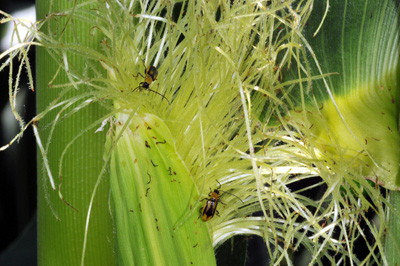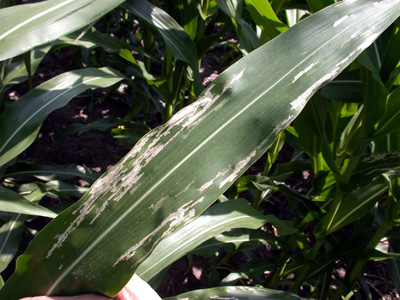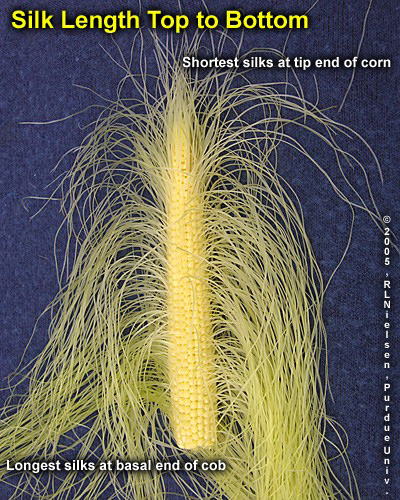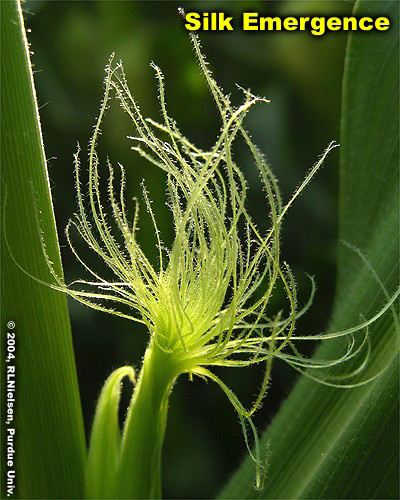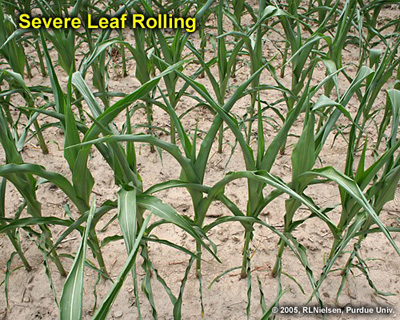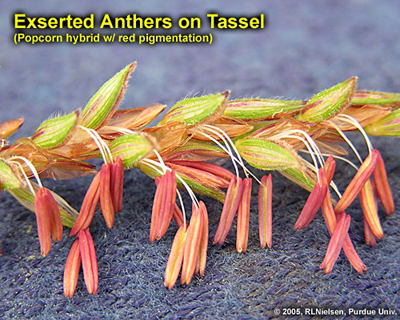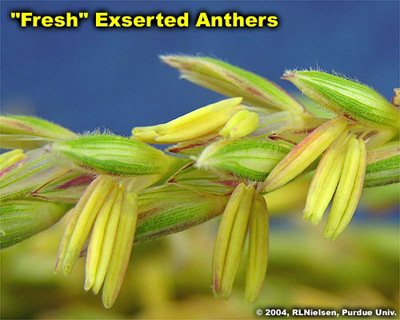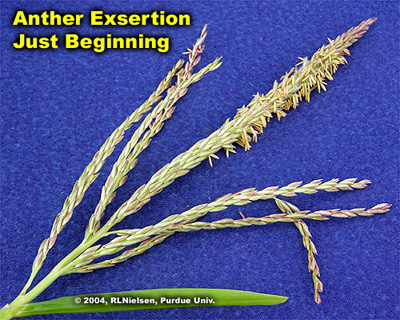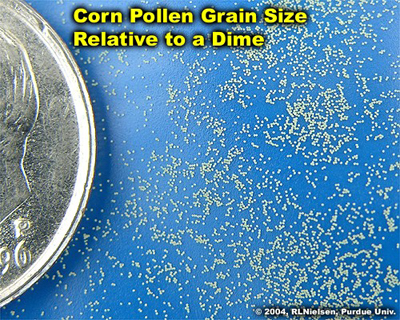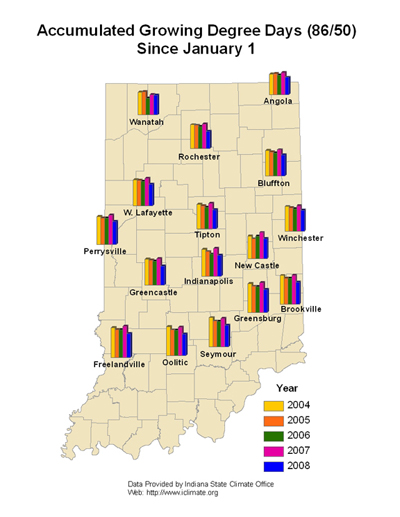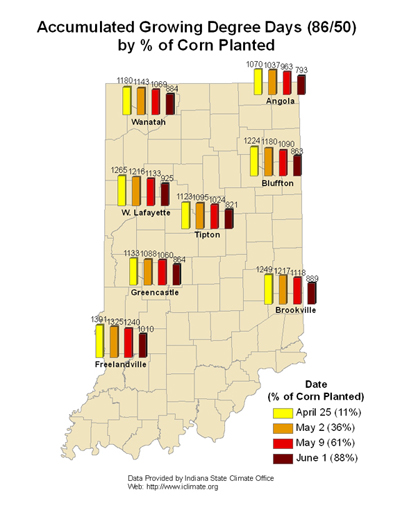Pest & Crop Newsletter, Entomology Extension, Purdue University
A Nibble here and There, Silk Feeding Insects Want Their Share – (John Obermeyer and Larry Bledsoe)
- Primary silk feeding insects are rootworm and Japanese beetles.
- Damage to silks, not insects numbers, is the critical factor.
- Delayed polinating fields may attract more rootworm beetles.
- Required reading...Bob Nielsen's articles on tassel/silk emergence and pollen shed.
Corn pollination has begun throughout the state, some late-planted fields are still over a couple weeks away. Pollinating corn should be monitored for insects that feed on pollen and silks. Especially this year, as many fields are delayed and may become a “trap crop” for these silk feeders. Rootworm beetles are most often observed. Others, such as the Japanese beetle and woollybear caterpillars can occasionally cause some concern.
Rootworms have been delayed in development this year because of the cool spring, but beetles are now emerging throughout the state. From reports received, it seems as though beetle numbers are down, indicating high larval mortality from the saturated soils in late May/early June. If rootworm beetles are present in commercial corn fields during pollination, control may be necessary if the silks are clipped off to within 1\2 inch or less of the tip of the ear before 50% pollination is completed. Don’t judge the need for treatment based on beetle numbers. If you are wondering, this threshold remains, even with today’s higher commodity prices.
Western corn rootworm beetles causing minor damage to silks
Although rootworm beetles prefer to feed on corn pollen and silks, they will feed on corn leaves before pollination begins. When the beetles feed on the leaves, they remove the upper layer of leaf tissue resulting in areas on the leaf that appear gray or silver. It has not been shown that this leaf feeding results in any loss in yield.
Japanese beetle will feed on silks, although beetle numbers throughout the state also seem to be lower. Base treatment decisions on degree of silk clipping and stage of pollination. Treatment is probably justified if beetles are continually clipping silks to within 1/2 inch or less of the ear tip before 50% pollination has taken place. Japanese beetle infestations are usually spotty in fields, especially in the end-rows. Don’t be overly alarmed at the few ears that may be clumped with these “social” insects. Be certain to inspect the whole field. Japanese beetle are attracted to the smell of dying and/or dead silks. Therefore, determine whether pollination is nearing completion before treatment decisions are made.
Please refer to Bob Nielsen’s articles in this week’s “Agronomy Tips” to better understand this a-maize-ing process. In doing so, you’ll understand why corn typically pollinates completely, even in the presence of significant beetle numbers. Happy scouting!
Rootworm beetle leaf feeding, sometimes mistaken for leaf disease
![]()
Silk Emergence – (Bob Nielsen)
- Corn produces individual male and female flowers on the same plant.
- The ear represents the female flower of the corn plant.
- Severe soil moisture deficits can delay silk emergence and disrupt the synchrony of pollen shed and silk availability, resulting in poor kernel set.
As important as the process of pollination is to the determination of grain yield in corn, it is surprising how little some folks know about the details of cornfield sex. Rather than leaving you to learn about such things “in the streets”, take the time to read this article and the accompanying one on tassels and anthers (Nielsen, 2007b) that describe the ins and outs of this critical period of the corn plant’s life cycle.
The corn plant produces individual male and female flowers (a flowering habit called monoecious for you corny trivia fans.) Interestingly, both flowers are initially bisexual (aka “perfect”), but during the course of development the female components (gynoecia) of the male flowers and the male components (stamens) of the female flowers abort, resulting in tassel (male) and ear (female) development.
The silks that emerge from the ear shoot are the functional stigmas of the female flowers of a corn plant. Each silk connects to an individual ovule (potential kernel). A given silk must be pollinated in order for the ovule to be fertilized and develop into a kernel. Up to 1000 ovules typically form per ear, even though we typically harvest only 400 to 600 actual kernels per ear.
Technically, growth stage R1 (Ritchie et. al., 1993) for a given ear is defined when a single silk strand is visible from the tip of the husk. A field is defined as being at growth stage R1 when silks have emerged on at least 50 % of the plants.
Silk Elongation and Emergence
Silks begin to elongate from the ovules about 10 days prior to growth stage R1. Silk elongation begins first from the basal ovules of the cob, then proceeds sequentially up the ear. Similarly, silks from the basal (butt) portion of the ear typically emerge first from the husk, while the tip silks generally emerge last. Complete silk emergence from an ear generally occurs within four to eight days after the first silks appear.
As silks first emerge from the husk, they lengthen as much as 1.5 inches per day for the first day or two, but gradually slow over the next several days. Silk elongation occurs by expansion of existing cells, so elongation rate slows as more and more cells reach maximum size. Once pollinated, elongation of an individual silk will stop.
Silk elongation stops about 10 days after silk emergence, regardless of whether pollination occurs, due to senescence of the silk tissue. Unusually long silks can be a diagnostic symptom that the ear was not successfully pollinated.
Silks remain receptive to pollen grain germination up to 10 days after silk emergence, but to an ever-decreasing degree. Natural senescence of silk tissue over time results in collapsed tissue that restricts continued growth of the pollen tube. Silk emergence usually occurs in close synchrony with pollen shed, so that duration of silk receptivity is normally not a concern. Failure of silks to emerge in the first place, however, does not bode well for successful pollination.
Pollination and Fertilization
For those of you serious about semantics, let’s review two definitions relevant to sex in the cornfield. Pollination is the act of transferring the pollen grains to the silks by wind or insects. Fertilization is the union of the male gametes from the pollen with the female gametes from the ovule. Technically, pollination is almost always successful (i.e., the pollen reaches the silks), but unsuccessful fertilization (i.e., pollen tube failure, silk failure, pollen death) will fail to result in a kernel.
Pollen grain germination occurs within minutes after a pollen grain lands on a receptive silk. A pollen tube, containing the male genetic material, develops and grows inside the silk, and fertilizes the ovule within 24 hours. Pollen grains can land and germinate anywhere along the length of an exposed receptive silk. Many pollen grains may germinate on a receptive silk, but typically only one will successfully fertilize the ovule.
Silk Emergence Failure
Severe Drought Stress. The most common cause of incomplete silk emergence is severe drought stress. Silks have the greatest water content of any corn plant tissue and thus are most sensitive to moisture levels in the plant. Severe moisture deficits will slow silk elongation, causing a delay or failure of silks to emerge from the ear shoot. If the delay is long enough, pollen shed may be almost or completely finished before receptive silks are available; resulting in nearly blank or totally blank cobs. Severe drought stress accompanied by low relative humidity can also desiccate exposed silks and render them non-receptive to pollen germination.
The severity of drought stress required for significant silk emergence delay or desiccation can probably be characterized by severe leaf rolling that begins early in the morning and continues into the early evening hours. Such severe leaf rolling is often accompanied by a change in leaf color from “healthy” green to a grayish-tinged green that may eventually die and bleach to a straw color.
Silk Clipping by Insects. Although technically not defined as silk emergence failure, severe silk clipping by insects such as corn rootworm beetle or Japanese beetle nonetheless can interfere with the success of pollination by decreasing or eliminating viable or receptive exposed silk tissue. Fortunately, unless the beetle activity is nonstop for days, continued elongation of silks from the husk will expose undamaged and receptive silk tissue at the rate of about one inch or more per day.
Related References
Kling, Jennifer G. and Gregory Edmeades. 1997. Morphology and growth of maize. IITA/CIMMYT Research Guide 9. Int’l Institute of Tropical Agriculture. [On-Line}. Available at <http://www.iita.org/cms/details/trn_mat/irg9/irg9.htm> (URL verified 7/2/07).
Nielsen, R.L. (Bob). 2007a. A Fast & Accurate Pregnancy Test for Corn. Corny News Network, Purdue Univ. [On-Line]. Available at <http://www.kingcorn.org/news/timeless/EarShake.html> (URL verified 7/2/07).
Nielsen, R.L. (Bob). 2007b. Tassel Emergence & Pollen Shed. Corny News Network, Purdue Univ. [On-Line]. Available at <http://www.kingcorn.org/news/timeless/Tassels.html> (URL verified 7/2/07).
Ritchie, S.W., J.J. Hanway, and G.O. Benson. 1993. How a Corn Plant Develops. Iowa State Univ. Sp. Rpt. No. 48. [On-Line] Available at <http://www.extension.iastate.edu/pages/hancock/agriculture/corn/corn_develop/
CornPlantStages.html> (URL verified 7/2/07).
Russell, W.A. and A.R. Hallauer. 1980. Corn. (a chapter in) Hybridization of Crop Plants. American Soc. of Agronomy-Crop Science Soc. of America. Madison, WI.
Steffey, Kevin. 2005. Rootworm Adults and Silk Clipping. Pest & Crop Bulletin, Univ. of Illinois. [On-Line]. Available at <http://www.ipm.uiuc.edu/bulletin/article.php?issueNumber=15&issueYear=
2005&articleNumber=2> (URL verified 7/4/07).
![]()
Tassel Emergence & Pollen Shed - (Bob Nielsen)
- Corn produces individual male and female flowers on the same plant.
- The tassel represents the male flower of the corn plant.
Over the next several weeks, the Indiana corn crop will move into the critical flowering stages of pollen shed and silk emergence. Success or failure during this period of the corn plant’s life will greatly influence the potential yield at harvest time.
As important as this process is to the determination of grain yield, it is surprising how little some folks know about the whole thing. Rather than leaving you to learn about such things “in the streets”, I’ve developed this article and the accompanying one on silking (Nielsen, 2007b) that describe the ins and outs of sex in the corn field.
Remember that corn has both male flowers and female flowers on the same plant (a flowering habit called monoecious for you trivia fans.) Interestingly, both flowers are initially bisexual (aka “perfect”), but during the course of development the female components (gynoecia) of the male flowers and the male components (stamens) of the female flowers abort, resulting in tassel (male) and ear (female) development.
Technically, growth stage VT occurs when the last branch of the tassel emerges from the whorl (Ritchie et. al., 1993). Portions of the tassel may be visible before the maximum leaf stage (final visible leaf collar) has occurred. Plant height is nearly at its maximum at growth stage VT. Pollen shed may begin before the tassel has completely emerged from the whorl.
The corn plant is most vulnerable to hail damage at growth stage VT since all of its leaves have emerged. Complete (100 %) leaf loss at growth stage VT will usually result in complete (100 %) yield loss by harvest. Even if pollination is successful, the ear shoots will usually die because few leaves remain to produce the necessary carbohydrates (by photosynthesis) to complete grain fill.
An individual tassel produces approximately 6,000 pollen-bearing anthers, although hybrids can vary greatly for this number. The anthers are those ‘thingamajigs’ that hang from the tassel during pollination. Under a magnifying lens, anthers look somewhat like the double barrel of a shotgun. Approximately 1,000 individual spikelets form on each tassel and each one bears two florets encased in two large glumes. Each floret contains three anthers. An anther and its attached filament comprise the stamen of the male flower.
As these florets mature, elongation of the filaments helps exsert the anthers from the glumes. Pollen is dispersed through pores that open at the tips of the anthers. Pollen shed usually begins in the mid-portion of the central tassel spike and then progresses upward, downward and outward over time. Anthers typically emerge from the upper floret of the pair first, while those from lower floret typically emerge later the same day or on following days. Spent anthers eventually drop from the tassel and are sometimes mistaken for the pollen when observed on the leaves or ground.
The yellow or white “dust-like” pollen that falls from a tassel represents millions of individual, nearly microscopic, spherical, yellowish- or whitish translucent pollen grains. Estimates of the total number of pollen grains produced per tassel range from 2 to 25 million. Each pollen grain contains the male genetic material necessary for fertilizing the ovary of one potential kernel.
The outer membrane of a pollen grain is very thin. Once dispersed into the atmosphere, pollen grains remain viable for only a few minutes before they desiccate. Yet, with only a 15 mph wind, pollen grains can travel as far as 1⁄2 mile within those couple of minutes.
Therein lies the concern of the potential for pollen “drift” from a transgenic corn field to an adjacent non-transgenic corn field and the risk of transgenic “contamination” of grain intended for non-transgenic markets. The good news is that recent research suggests that the overwhelming majority of a corn field’s pollen load is shed in the field itself.
All of the pollen from a single anther may be released in as little as three minutes. All the anthers on an individual tassel may take as long as seven days to finish shedding pollen, although the greatest volume of pollen is typically shed during the second and third day of anther emergence. Because of natural field variability in plant development, a whole field may take as long as 14 days to complete pollen shed.
Peak pollen shed usually occurs in mid-morning. Some research indicates that pollen shed decreases after temperatures surpass 86F. A second “flush” of pollen often occurs in late afternoon or evening as temperatures cool. Pollen shed may occur throughout most of the day under relatively cool, cloudy conditions.
Weather conditions influence pollen shed. If the anthers are wet, the pores will not open and pollen will not be released. Thus, on an average Indiana summer morning following a heavy evening dew, pollen shed will not begin until the dew dries and the anther pores open. Similarly, pollen is not shed during rainy conditions. Cool, humid temperatures delay pollen shed, while hot, dry conditions hasten pollen shed.
Extreme heat stress (100 F or greater) can kill corn pollen, but fortunately the plant avoids significant pollen loss by virtue of two developmental characteristics. First of all, corn pollen does not mature or shed all at once. Pollen maturity and shed occur over several days and up to two weeks. Therefore, a day or two of extreme heat usually does not affect the entire pollen supply. More importantly, the majority of daily pollen shed occurs in the morning hours when air temperature is much more moderate.
Related References
Kling, Jennifer G. and Gregory Edmeades. 1997. Morphology and growth of maize. IITA/CIMMYT Research Guide 9. Int’l Institute of Tropical Agriculture. [On-Line}. Available at <http://www.iita.org/cms/details/trn_mat/irg9/irg9.htm> (URL verified 7/2/07).
Nielsen, R.L. (Bob). 2007a. A Fast & Accurate Pregnancy Test for Corn. Corny News Network, Purdue Univ. [On-Line]. Available at <http://www.kingcorn.org/news/timeless/EarShake.html> (URL verified 7/2/07).
Nielsen, R.L. (Bob). 2007b. Silk Emergence. Corny News Network, Purdue Univ. [On-Line]. Available at <http://www.kingcorn.org/news/timeless/Silks.html> (URL verified 7/2/07).
Ritchie, S.W., J.J. Hanway, and G.O. Benson. 1993. How a Corn Plant Develops. Iowa State Univ. Sp. Rpt. No. 48. [On-Line]. Available at <http://www.extension.iastate.edu/pages/hancock/agriculture/corn/corn_develop/
CornPlantStages.html> (URL verified 7/2/07).
Russell, W.A. and A.R. Hallauer. 1980. Corn. (a chapter in) Hybridization of Crop Plants. American Soc. of Agronomy-Crop Science Soc. of America. Madison, WI.

